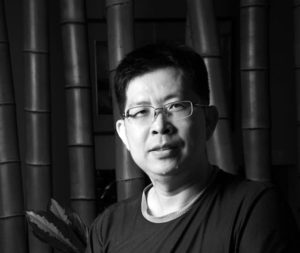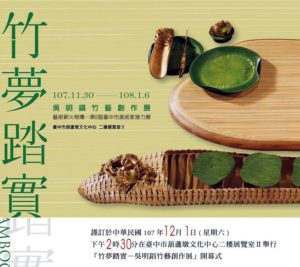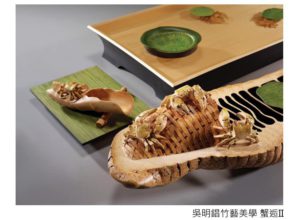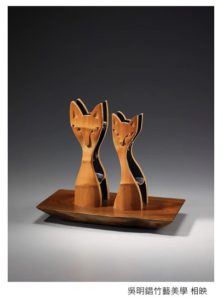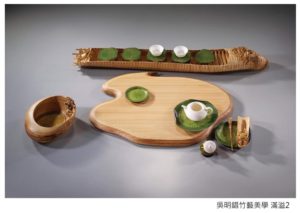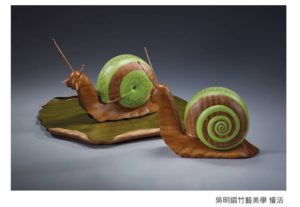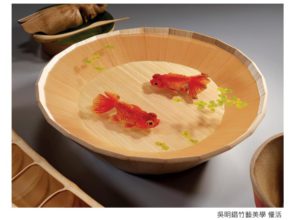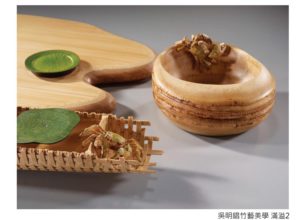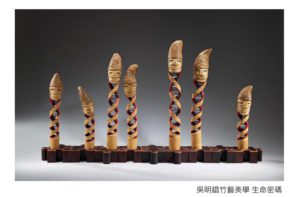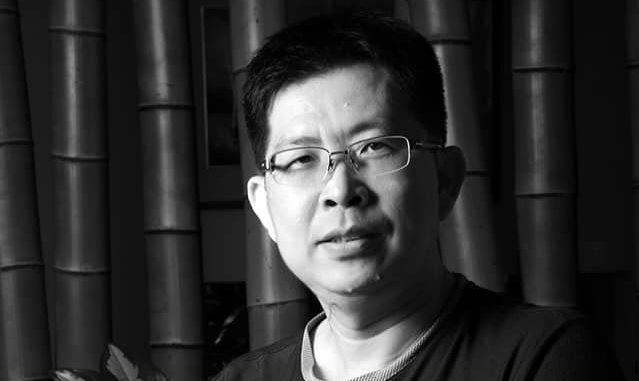
2,660 total views, 1 views today
《吳明錩一位用生命完成竹材創作可能性的創作者》
圖片 英文譯文提供/吳明錩 黃瑞慶 撰文/紀 向
— 竹夢踏實 — 吳明錩竹藝創作展
藝術薪火相傳—第8屆臺中市美術家接力展
開幕式:107年12月1日 下午2:30
地點:臺中市葫蘆墩文化中心 二樓展覽室∥
臺中市豐原區圓環東路782號
展期:107.11.30—108.1.6
「竹」在亞熱帶台灣,是平常山坡植物,但是竹除了生活外,歷代以來也不時寫入文人創作文辭當中如:
唐朝詩人劉禹錫《庭竹》詩品有道:
「露滌鉛粉節,風搖青玉枝」。
〈清.鄭燮竹石圖〉更為竹題詩
咬定青山不放鬆,立根原在破岩中。
千磨萬擊還堅勁,任爾東西南北風。
所以竹的存在性,除了通俗生活以外,卻也可以成為一種倍具風雅極致,更是高尚手玩的物件。
現代工藝美學領域,除了承襲傳統器物外,不外乎是利用精緻工藝與手工技藝來完成,但是在此文明進步的環境,想以創作作為職志者,創作題材的選擇,也是以能簡巧容易入手為主,或是具有龐大市場趨向的材料為其創作媒材。而竹在眾多材料的分別上,是屬於一種低層的材料,主要也是其取得過度容易,更是一種稀鬆平常的材料,麻煩的是,為了完成作品的形式,材質的適應性與完成的困難度,卻異於其他材質的製作,也比一般木雕泥塑創作來得困難。在此台灣多年來確實出現幾位以竹作為媒材的創作者,但是大環境的發展,卻也受限於以上因素,所以在創作的人才後繼略顯疲乏。
但是在近年幾個大型藝術比賽中,卻累次出現,有以竹作為創作媒材精緻創作作品產生,不經意初次窺視這些作品,的確是現代思維的美麗作品,而近觀,更發現是一種幾乎銷聲匿跡的竹材工藝的現代創作品,在此更以另一種期待心態此類作品的後繼。由作品整體再觀察這位作者的作品層次,確實也已經離開傳統竹工藝創作的窠臼,而這位創作者卻是一位學機械工程出身年紀輕輕的創作者 吳明錩。
吳明錩學習背景為機械、廣告工程的專業,只因為多年前個人的喜好,而戮力在竹材的認識,因而也誘導出一份屬於吳明錩的創作本能。而他利用竹材來創作,除了基本工藝必須具有的技藝以外,一種機械本科訓練的理性本能,與數位專業的認知,也讓他應用於竹的創作領域上。所以在傳統竹材創作作品的物件上,也仍然保有一些精湛傳統技藝的影子,但是近年來出品的竹藝作品,卻已完全離開一般人認知的竹工藝範疇,他選擇季節去精挑一些創作的老竹頭、竹鞭或是使用一些再經自己加工的竹裡層,構成大家熟悉的有茶席文化內涵的精緻茶具組作品,如此的作品近年來為他拿到全國幾個重要的大獎項,如大墩獎ˋ玉山獎、臺灣工藝獎與南瀛獎等等的重要獎項,在在肯定他多年來在創作上努力的成就。
他的茶具系列作品中,常以一種現代禪美學的觀念來完成。茶組中的茶盤內側他用凝膠完全固著,製造一種既有小水景的作品,完成一種形而上的超現實空間造景意境,讓茶道玩賞者心境上也融入小山水意境當中。而一件件黑面琵鷺的造型創作或原住民造型的原竹作品,顯現作者不僅是創作者,他內心那份對於台灣這土地的愛,更是值得欽佩。
此外,他也曾以專業製圖數位製程的能力,配合國立臺灣工藝研究發展中心舉辦的產品開發設計案,以他對竹專業的認知,和多位外國設計師合作,完成了數件頗有現代設計味道的作品。如此的作品已經離開傳統竹工藝觀念的認知,他能完全利用竹材的特性,再以其機械背景、數位設計能力,來完成了一些或許是台灣產業未來趨向的作品,同時也是吳明錩在自我創作領域上的突破及重要觀念轉折的契機點。
一位有企圖有能力的創作者,是不會安於現狀成就的光芒中,多年來吳明錩除了準備以上諸項比賽作品外,也進入設計學院碩士班進修,接觸一些更進階的創作與藝術觀念。在此吳明錩創作作品不但能將美學觀念與作品做適當的結合外,相信今後更能清楚地做出一件件屬於他自己創作理念的作品。
藉由吳明錩一路創作的努力歷程,我們發現了一股原本就屬於台灣特有的活力與競爭力;也經由他的系類作品展出,讓我們看見存在於吳明錩內心一個個繼續成長的優質作品,漸漸在台灣被發現。
紀 向 專業藝術創作
Ming-Chang Wu – An Artist Who Spent His Life Exploring All Possibilities of Bamboo Art Creations
In subtropical Taiwan, “bamboo” is a common plant seen on the hillsides. But apart from everyday uses, bamboo has also been included in the works of many literati throughout the ages, such as the poet from the Tang dynasty, Liu Yuxi, who wrote in his poem “Courtyard Bamboo”: “Dew drops bathe the powdery green nodes, emerald branches flutter in the breeze.” The Qing dynasty artist Zheng Xie even wrote a poem about bamboos for his “Bamboo and Rock Painting”: “Holding steadfast to the verdant mountain, standing firm in the broken rocks. Strong and resilient through a thousand hardships, resolute and unflinching however the winds may blow.” Therefore, in addition to everyday life, the existence of the bamboo can also be something elegant and classy, it can even be used for sophisticated artworks.
In modern handicraft aesthetics, apart from passing down the legacy of traditional artifacts, the pieces are completed under refined craftsmanship and hand-crafting techniques. However, in this civilized and advanced environment, for those who want to go on the career path of artistic creations, most people’s choice of creative subjects are based on that which are simple and easy to handle, or creative mediums that are based on materials with a large market trend. Out of the many different materials, bamboo is a low-level material, mainly because it is extremely easy to obtain, and it is also a common and ordinary material. But the problem lies in the forms of the works to be completed, it differs to production using other materials in its material adaptability and difficulty in completion, and it is also more difficult than ordinary wood carving or clay sculpting. Therefore, even though there has indeed been several artists in Taiwan who used bamboo as their creative medium over the years, they have been restricted by the above factors due to the development of the overall environment and there has been a dearth or artistic talents in this field in the later years.
But at large-scale art competitions over the recent years, there have been recurring appearances of exquisite artworks made from bamboo. A chance first glimpse of these artworks revealed that they were indeed lovely pieces created under modern-thinking, but a closer observation showed modern artworks created using bamboo crafting techniques which have all but disappeared today. So with a different mindset, I look forward to the successive creations of this type of artwork. From the overall observation of artworks to see the artist’s creative level, it was found that the pieces have indeed left the traditional mode of bamboo craftsmanship. Their creator is Ming-Chang Wu, a young bamboo artist with a background in mechanical engineering.
Ming-Chang Wu has an educational background in mechanical engineering and a professional background in advertising engineering, but due to his own personal preferences many years back, he has dedicated himself to learning about the bamboo as a material which had in turn induced the creative capabilities that are unique to him. He uses bamboo as the creative medium, in addition to the techniques required for basic crafting, he has also applied the idealized thinking from his mechanical engineering and knowledge from the advertising profession to the field of bamboo creation. So on the traditional bamboo craft pieces, one can still see traces of exquisite traditional craftsmanship, but when it comes to the bamboo works created in recent years, they have departed completely from people’s understanding of bamboo handicrafts. For his works, he carefully selects seasonal old bamboo stumps and rhizomes, or the inner membranes that he has processed himself to create refined tea sets that are familiar to the public and imbued with elements of the tea ceremony culture. Such works have won him major awards from around Taiwan in recent years, including the Da Dun Prize, Yushan Award, National Craft Achievement Award, and Nanying Award, serving as recognition to his hard-earned creative accomplishments over the years.
His tea set creations are often completed through the concept of a modern Zen aesthetics. He has glued down the saucers of the tea set to create the imagery of a tiny waterscape in the artwork, presenting a scenic ambience through the metaphysical and surreal space, which draws the mood of the tea ceremony appreciator to merge with the Shanshui atmosphere. The various bamboo creations and artworks based on the black-faced spoonbill or on the Taiwanese aborigine designs show that the artist is not merely a creator, but that his passion for Taiwan is also worthy of respect.
In addition, using his professional expertise in digital drafting processing, he has also taken part in the product design projects organized by the National Taiwan Craft Research and Development Institute and collaborated with numerous overseas designers and completed many pieces of modernistic artworks based on his professional knowledge of bamboo. Such works have already departed from the general understanding of traditional bamboo handicrafts, he was able to fully utilize the characteristics of bamboo together with his mechanical engineering background and digital design skills to complete works which might actually be the future trend of Taiwan’s industry. At the same time, these are also Ming-Chang Wu’s self-breakthroughs in the creative discipline as well as a turning point of important concepts.
An artist with ambition and skills will not be satisfied with remaining under the glory of the current achievements. In addition to preparing the works for the above competitions over the years, Ming-Chang Wu has also entered the Master’s program at a design institute to learn more about advanced creative and art concepts. Ming-Chang Wu has not only suitably combined aesthetic concepts to his artworks, it is certain that he will be able to create many pieces that has his exclusive creative concept in the future.
Through Ming-Chang Wu’s dedication all along the creative path, we discovered a sense of vitality and competitiveness that is unique to Taiwan. In addition, through the exhibition of his works, we see that each of the excellent works that is incubating inside the mind of Ming-Chang Wu is gradually being discovered in Taiwan.
Chi,Xiang Professional Artistic Creation
吳明錩專業藝術創作 竹美學研究 個展得獎/大墩獎 玉山獎

